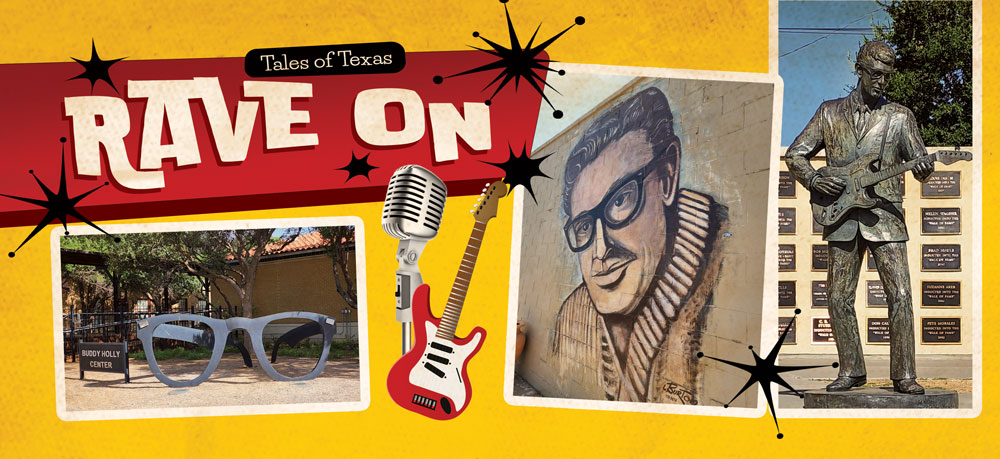
The day was February 2, 1959. Buddy Holly was 22 years old, had 25 hit records already to his credit, was the lead singer of The Crickets and had assembled a group of musicians for the Winter Dance Party Tour across America’s Midwest. By then, The Crickets included Waylon Jennings, Tommy Allsup and Carl Bunch. Other performers, Ritchie Valens, J.P. “The Big Bopper” Richardson and Dion and the Belmonts, were on the tour, too. It was a cold, miserable day in Clear Lake, Iowa, as Buddy chartered a small, private plane for himself, Waylon and Tommy. Waylon gave his seat to J.P., who was sick with the flu, and Tommy lost a coin toss for his seat with Ritchie. The plane took off, never to reach its destination. Buddy’s famous black horn-rimmed glasses were found in the wreckage. As Don McLean’s 1970s song, “American Pie” notes, some say that was the “day the music died.”
Charles Hardin Holley was born on September 7, 1936, in Lubbock, Texas. His parents, Lawrence and Ella Holley, named him after his maternal and paternal grandfathers, but the name seemed a bit long, so his mother called him “Buddy.” The extra “e” in his surname was dropped by Buddy after Decca Records misspelled it on his first contract. Still very young, Buddy signed the contract Buddy Holly because he was afraid if he changed it, the opportunity would vanish.
In early childhood, Buddy enjoyed typical activities of the day — Scouts, fishing, baseball, drawing horses, leatherworking, clay modeling and woodworking. He created several guitar straps. His interests weren’t scholastically inclined, but he did well enough to graduate from Lubbock High School.
Developing an interest in music at an early age, Buddy was encouraged by his musical family to play instruments in the country, gospel, bluegrass and rhythm and blues genres. While a student at Lubbock’s Hutchinson Junior High, Buddy met Bob Montgomery. They started playing music together in 1949, mostly country western and Hank Williams songs. Hipockets Duncan, a local radio personality, started managing the group, which had added Sonny Curtis and Larry Welborn. They performed regularly at various locations around Lubbock including roller rinks, parking lots and the Cotton Club. They were on local station KDAV’s Sunday Party, playing songs requested by listeners, and they opened for Elvis when he came to town on his second tour. By age 16, Buddy wrote in an essay, “I have thought of making a career out of western music if I am good enough, but I will just have to wait and see how that turns out.”
He wasn’t waiting long. In 1955, talent agent Eddie Crandall obtained a recording contract for Buddy at Decca. Buddy wasn’t artistically happy with Nashville, so he sought out Norman Petty’s independent recording studio in Clovis, New Mexico, near Lubbock. The original Crickets included Buddy, Jerry Allison, Joe Mauldin and Niki Sullivan. They named their band, according to folklore, because they heard a cricket sound at the end of one of those early recordings. The first successful single, “That’ll Be the Day,” was written by Buddy and Jerry.
The band toured the U.S., Australia and in 1958, toured England, where they influenced The Beatles, The Rolling Stones and Elton John, all who were just starting their careers. The Rolling Stones’ first hit, “Not Fade Away,” was a Buddy Holly song, and Elton John started wearing unnecessary glasses to be more like Buddy.
The Fender Stratocaster was Buddy’s choice of guitars, but he also played a Gibson acoustical guitar. Buddy’s Fenders are considered by some to be the “holy grail of rock ’n’ roll.” The great lyrics of “Peggy Sue,” “Words of Love” and “Maybe Baby” were sung to Buddy’s strumming on his Fenders.
On a New York City tour, Buddy met María Elena Santiago and proposed marriage to her the same day. They were married two months later on August 15, 1958. María Elena influenced Buddy’s life and music from then to today as a supporter of the Buddy Holly Center in Lubbock, where his glasses and other memorabilia are displayed. There and on the Buddy Holly Trail in Lubbock, visitors can enjoy Buddy’s own unique rockabilly sound, which he created during the earliest days of rock ’n’ roll. As it influences other artists, the music still lives on.
Photos by Virginia Riddle, L.L.C.
Sources:
1. www.buddyhollycenter.org.
2. www.buddyhollyarchives.com.
Written by Virginia Riddle

You must be logged in to post a comment.